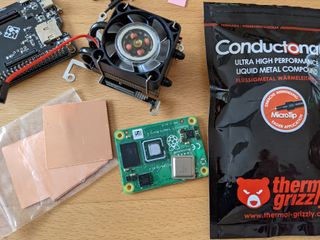Extreme Overclocker Takes Raspberry Pi to 3 GHz
Extreme overclock requires extreme action

Some people will do anything for a speed boost, prying the lids off expensive i9s and subjecting them to all manner of chilly chemical concoctions to drag every last megahertz out of the silicon. We’ve not seen anybody do such an extreme overclock with a Raspberry Pi before, but there's a first time for everything. Claude Schwarz has overclocked his Raspberry Pi Compute Module 4 to an extraordinary 3 GHz.
🎉 3.0GHz CM4 🎉 But total unpractical because cooled with ice spray pic.twitter.com/LZo0Yua0J8October 13, 2021
Schwarz, who’s no stranger to the Raspberry Pi boards thanks to his PiStorm project, took a Compute Module 4 - the Lite version, sitting in a PiTray mini carrier board from Sourcekit - and removed the heat spreader that usually sits above the Broadcom BCM2711C0 SoC. He applied a liquid metal thermal paste (Thermal Grizzly Conductonaut) based on gallium, tin and indium, then replaced the heat spreader. To reach the magic 3 GHz Schwarz had to use a few blasts of ice spray, so while this is an impressive feat, it's not one for regular users.


Schwarz's earlier efforts saw him overclock the Compute Module 4 to 2.89 GHz, still an extreme speed boost over the stock 1.5 GHz. As well as using liquid metal thermal paste, Schwarz used active cooling on the Compute Module 4 in the form of a heatsink and fan designed for the Raspberry Pi (which could be a 52Pi model cooler). Taking the steps to overclock even further Schwarz disabled power management features to unlock a higher overclock, resulting in much higher CPU speeds than we can achieve with a typical overclock. We should probably say at this point that anyone doing this is on their own, as these extreme actions will definitely void your warranty, and we take no responsibility for whatever happens if you try it.
A little more fumbling in the Pi’s firmware - what Schwarz refers to as “removing all safety nets” - and the CM4 is running at an impressive 2.4GHz at 26.2°C (79.16°F). Not bad for a board that started life at 1.5GHz and didn’t require cooling.
Stay on the Cutting Edge
Join the experts who read Tom's Hardware for the inside track on enthusiast PC tech news — and have for over 25 years. We'll send breaking news and in-depth reviews of CPUs, GPUs, AI, maker hardware and more straight to your inbox.

Ian Evenden is a UK-based news writer for Tom’s Hardware US. He’ll write about anything, but stories about Raspberry Pi and DIY robots seem to find their way to him.
-
passivecool Claude, why no LN2?Reply
What a waste of human potential. The OC community should do something useful for humanity, like go collect garbage from the streets. -
derekullo Reply
Why are your streets littered with garbage?passivecool said:Claude, why no LN2?
What a waste of human potential. The OC community should do something useful for humanity, like go collect garbage from the streets.
Have you reported it to Waste Management or the city council? -
CooliPi Replypassivecool said:Claude, why no LN2?
We did, the second LN2 session is however postponed.
The first attempt 2 years ago is here
RbzKM5XxlOAView: https://www.youtube.com/watch?v=RbzKM5XxlOA
Most Popular


